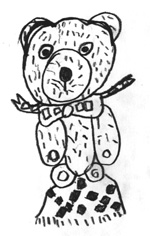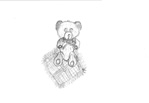|
|
|
|
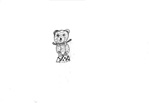 |
| This
boldly patterned teddy accounts for most of the texture and pattern features of
the subject in a schematic manner. The form is strongly outlined in a confident
manner. The textural style is shown in bold randomised hair marks and ordered
checks in the fabric. There is no apparent attempt at tone and only a rudimentary
grasp of proportion. Textured Teddy remains perched on his patterned cloth with
his patterned scarf fluttering. As can be seen from the scale of the drawing it
is a little tentative in size. There is an internal coherence in this work with
an individualised expressive effect achieved from the emphasis on patterning. |
| |
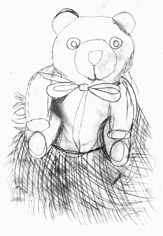 |
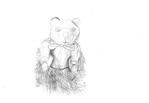
|
| Care
has been taken to render the plump proportions and arrangement of the limbs. The
scale and accuracy of proportions is confident, with indications that the drawer
has self–corrected and strengthened some lines in preference to others. The
ovals of the front arms describe their spatial disposition. The slight inclination
of the head and subtle emphasis to mouth, eyes and ears give an alert expression.
The form is strengthened by some soft shading in the deeper recesses of the body.
The smooth form of the body is contrasted by some vigorously textured hatching
which loosely describes the patterned draped cloth. Teddy sits believably within
this textured surface. |
| |
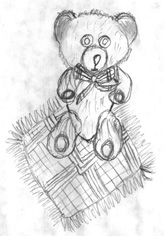 |
|
| Overlapping,
texture, and relative proportions are all suggested in this drawing. There is
some smudged tone on the ears. The cloth is shown in bird's–eye view. The
overall equal tone of all the mark making creates a lack of focal points and contrast
in the drawing. This makes every part of the drawing equal in its bid for our
attention. Consequently it appears to float upwards; differing textures and patterns
become diffuse rather than boldly stated. This gives an impression of tentativeness
and a mood of timidity in the bear. |
| |
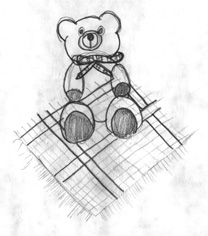 |
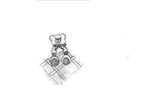 |
| This
is an example where the drawer has established a flattened view of the cloth first
and then superimposed the bear. The lines used are emphatic and enclosing with
no attempt at tone to indicate depth or roundness. The subtlety of the form has
been reduced to some circular and ovoid equivalents which are useful in establishing
initial proportions but remain unmodified in the final drawing. This gives the
drawing a somewhat formulaic response lacking the freshness of an observed experience. |
| |
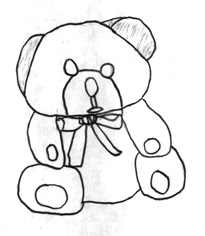 |
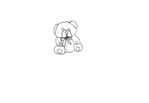 |
| Given
the time available this is a rather incomplete drawing. No attention is given
to tone, texture or detail apart from some very faint shading on the ears. However,
there is a clearly concentrated effort at the minor variations of form based on
observation. There is a reversal of the overlapping of arms and legs and simplification
of the leg view. The decisive emphatic line suggests confidence reinforced by
the accuracy of the overall proportions. |
| |
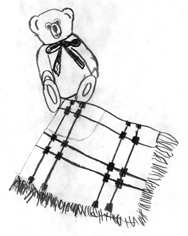 |
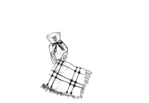 |
| The
drawer has described the bear and cloth independently of each other which suggests
difficulty with the handling of illusion of depth by overlapping. The cloth is
given a bird's–eye view while the bear is frontal. Each is given form by
line. Only two varieties of line are used: a soft focus grey and a more emphatic
dark line used more for pattern than describing tone. The feet are distorted to
completely conceal any view of the lower limbs, thus simplifying the challenge
of the observational task. The way the feet overlap the upper paws, however, does
indicate the beginnings of depth illusion. The relative proportions of bear and
cloth have been maintained. |
| |
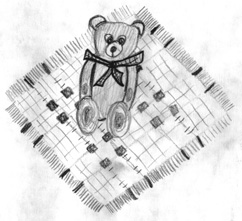 |
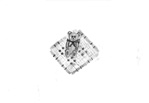 |
| Teddy
sits centrally placed inside a flattened perspective of the draped patterned cloth.
In order to render pattern, a birds–eye view of the cloth has been taken
and a frontal view of the bear added over the top. This is a common response in
children's work to the problems of illusionistic space. Each element is shown
in its completeness even though the student knows about overlapping as a means
of describing depth. The form is given strong outline with a suggestion of overall
tone and texture without variety in the mark making. Tones are handled in a stepwise
system as light, medium or dark without searching for the variety inside each
of those areas. The size of the drawing does not give much opportunity for more
detailed observation of surfaces and tone. The central placement with crisp presentation
suggests confidence. |
|
|
